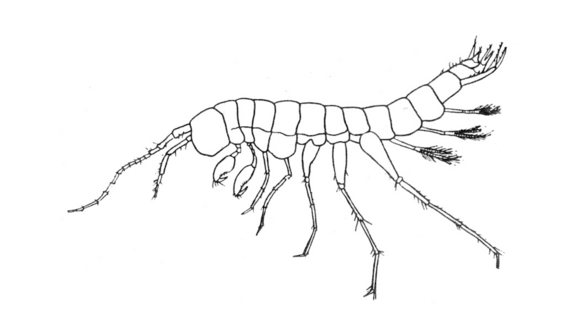- Scientific name: Stygobromus borealis
- Species of Greatest Conservation Need (MA State Wildlife Action Plan)
- Endangered (MA Endangered Species Act)
Description

Bell, R.T. 1971. Handbook of the Malacostraca of Vermont and neighboring regions (crayfish, sowbugs and their relatives). Published by author. Burlington, VT.
The Taconic cave amphipod is a laterally compressed, many segmented, freshwater crustacean that looks like a small, flat shrimp. As with other Stygobromus amphipods, the species is troglomorphic, lacking eyes, pigment, and possessing elongated appendages. Body coloration ranges from whitish, creamy, or straw-colored. The adults are approximately 3-4 mm (0.12-0.16 inches) in length. Males can be distinguished from females based on the characteristics of the terminal appendages (Holsinger 1978).
The Taconic cave amphipod can be confused with the larger piedmont groundwater amphipod (S. tenuis), which co-occurs with this species in Massachusetts. The piedmont groundwater amphipod is the only other subterranean amphipod known from Massachusetts. Identification guides sufficiently illustrate the differences among these species based on adult body length and the characteristics of spines on the appendages of the thoracic segments (Smith 2000).
Life cycle and behavior
Little is known of the life history of the Taconic cave amphipod. Adults are present year-round and reproductive females have been found in winter, spring, and fall (Holsinger 1978).
Distribution and abundance
The Taconic cave amphipod’s known range extends from eastern Canada south to Massachusetts and New York. In Massachusetts, the species is known from only one site in the karst terrain of the Taconic Mountains, which is scarce, and is presumed to be the southern edge of its range (Smith 1997). The species has been collected from only two other sites in the northern Taconic Mountains, one in Vermont and the other in New York (Holsinger 1978). The status of the Taconic cave amphipod population in Massachusetts is uncertain. The karst habitat where it is found is uncommon in Massachusetts. This amphipod is rarely encountered and is listed under the Massachusetts Endangered Species Act as Endangered. All listed species are protected from killing, collecting, possessing, or sale and from activities that would destroy habitat and thus directly or indirectly cause mortality or disrupt critical behaviors. In addition, listed animals are specifically protected from activities that disrupt nesting, breeding, feeding, or migration.
Habitat
The Taconic cave amphipod is a stygobiont, or a subterranean aquatic organism, found in upland karst terrain, which is soluble carbonate bedrock that forms underground networks of caverns and streams. This species is found in springs connected with deep aquifers in the extreme southern Taconic Mountains in southwestern Massachusetts (Smith 1986). In Massachusetts and New York, the only description of habitat has been from a springhouse in New Marlborough, MA (Smith 1986) and Rensselaer County, NY (Holsinger 1978), respectively. In Vermont, this species was found in a small cave of marble bedrock with a deep (probably > 9 m [30 ft]) pool of water with a silt and/or sand bottom.
Healthy habitats are vital for supporting native wildlife and plants. Explore habitats and learn about conservation and restoration in Massachusetts.
Threats
Potential threats to the Taconic cave amphipod are groundwater contamination and use. For example, springhouses where rare species have been found are often on private property and subject to owner discretion. If the spring outlets were dammed to create a pond for irrigation, livestock, or aesthetic reasons, this hydrologic alteration could be detrimental. Climate change may pose an additional threat to this species because of potentially reduced groundwater levels.
Conservation
Survey and monitoring
The last targeted survey effort for this species was in the early 1990s. As such, effort is needed to evaluate its historical distribution and persistence in Massachusetts. Surveys should also reserve effort to identify and target potentially suitable habitat in the Housatonic and Hoosic River watersheds. Monitoring efforts are recommended at least every five years or as needed at its historical sites.
Management
Protection of Taconic cave amphipod habitat is critical for species persistence in Massachusetts. Since the species’ known distribution is from only one site, alteration of groundwater levels, groundwater pollution (e.g., road salts), and spring and seep habitats should be minimized.
Research needs
Surveys should continue to target historical but also identify new carbonate rich springs and subterranean habitat to better understand its distribution, relative abundance, and habitat requirements in Massachusetts. Physical surveys coupled with eDNA collections could improve species detection, assuming species DNA markers are developed. Basic life history knowledge of this species in Massachusetts is also limited including longevity and reproductive timing. Further research is also needed to assess Taconic cave amphipod’s habitat and species risk to climate change projections, as these groundwater systems may be impacted by more frequent and prolonged droughts.
References
Bell, R.T. 1971. Handbook of the Malacostraca of Vermont and neighboring regions (crayfish, sowbugs and their relatives). Published by author. Burlington, VT. 65 pp.
Holsinger, J.R. 1978. Systematics of the subterranean amphipod genus Stygobromus (Crangonyctidae), Part II: Species of the eastern United States. Smithsonian Contributions to Zoology 266:110-113.
Holsinger, J.R. 1967. Systematics, speciation, and distribution of the subterranean amphipod genus Stygonectes (Gammaridae). Bull. U.S. Nat. Mus. 259:1-176.
Smith, D.G. 2000. Keys to the Freshwater Macroinvertebrates of southern New England. Published by author. Sunderland, MA. 243 pp.
Smith, D.G. 1997. An annotated checklist of Malacostracans (Crustacea) inhabiting southern New England fresh waters. Journal of Freshwater Ecology 12(2):217-223.
Smith, D.G. 1986 (1984-1985). The occurrence of the troglobitic amphipod, Stygobromis tenuis tenuis (Smith) (Crangonyctidae) in the Taconic Mountains of southwestern Massachusetts (USA): a case for the existence of a subterranean refugium in a glaciated region. International Journal of Speleology 14: 31-37.
Contact
| Date published: | March 12, 2025 |
|---|